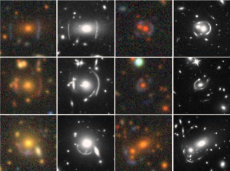Discovering Hundreds of New Gravitational Lenses
May 7, 2020

Side-by-side comparisons of gravitational lens candidates imaged by DECaLS (color) and the NASA/ESA Hubble Space Telescope (B&W). Image credit: DECaLs/ NASA / ESA / Hubble / Huang et al.
Science Achievement
Scientists used neural networks running on Cori to identify 335 new gravitational lens candidates from data collected for in the Dark Energy Camera Legacy Survey (DECaLS) .
Significance and Impact
Gravitational lensing occurs when a large mass bends light, according to the laws of Einstein’s General Relativity, from a background object. The images of lensed objects appear to observers on Earth as circles, arcs, and other distortions. Those shapes help scientists measure distances to galaxies, map the mass distribution of the universe, and investigate the nature of dark energy.
Research Details
- The lens candidates were identified with the assistance of a neural network, which is a form of artificial intelligence in which the computer program is trained to gradually improve its image-matching over time to provide an increasing success rate in identifying lenses.
- The team used the Shifter container technology developed at NERSC to run the “Tractor” software that applies neural networks to identify new candidates based on a training set of known lenses.
- DECaLS is one of the Dark Energy Spectroscopic Instrument (DESI) Legacy Imaging Surveys, conducted in preparation for the upcoming DESI survey.
Related Links
Huang, et al., "Finding Strong Gravitational Lenses in the DESI DECam Legacy Survey"; ASTROPHYSICAL JOURNAL, 894 2020 MAY, 10.3847/1538-4357/ab7ffb
About NERSC and Berkeley Lab
The National Energy Research Scientific Computing Center (NERSC) is a U.S. Department of Energy Office of Science User Facility that serves as the primary high performance computing center for scientific research sponsored by the Office of Science. Located at Lawrence Berkeley National Laboratory, NERSC serves almost 10,000 scientists at national laboratories and universities researching a wide range of problems in climate, fusion energy, materials science, physics, chemistry, computational biology, and other disciplines. Berkeley Lab is a DOE national laboratory located in Berkeley, California. It conducts unclassified scientific research and is managed by the University of California for the U.S. Department of Energy. »Learn more about computing sciences at Berkeley Lab.







